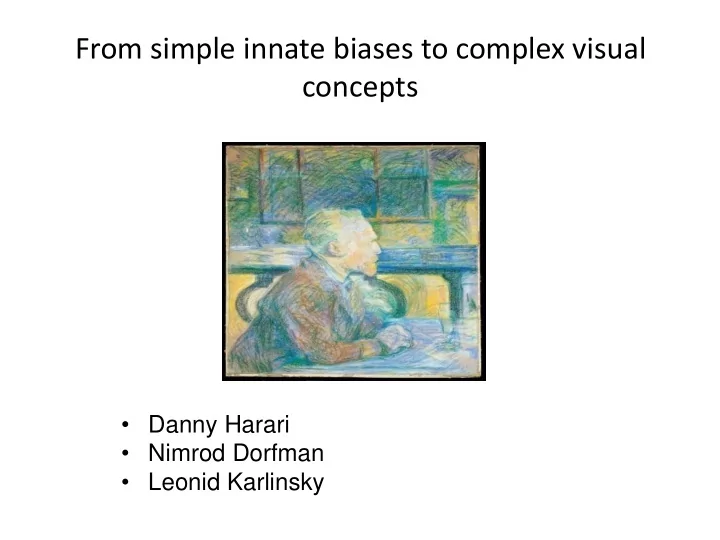

From simple innate biases to complex visual concepts • Danny Harari • Nimrod Dorfman • Leonid Karlinsky
How it all starts • Start without world knowledge • Watch many movies of the world • Develop representations of various concepts
Hands Gaze Difficult, appear early, important for subsequent learning of agents, goals, interactions,
Hands and body parts are important Action recognition Gesture and communication Agents interactions
Hands are difficult Multiple appearances Kirchner Van Gogh Small and inconspicuous
In humans: Selectivity to hands appear early in infancy Using a Head Camera to Study Visual Experience. ‘Overall…hand were in view and dynamically acting on an object in over 80 % of the frames’. Yoshida & Smith 2008 What makes hands learnable by humans?
Motion, Hand as ‘mover’ (7-months old) See: Saxe, Carey The perception of causality in infancy . Acta Psychologica 2006
Early sensitivity to special motion types • High sensitivity to motion in general (detecting motion, motion segmentation, tracking) • Specific sub-classes of motion: self- motion, passive, and ‘mover’ A specific motion even is highly indicative of hands
Detecting ‘Mover’ Events A moving image region causing a stationary region to move or change after contact. Simple and primitive, prior to objects or figure-ground segmentation
Movers detection ‘Mover’ as an innate teaching signal for hand Motion alone is insufficient
‘Mover’ events extracted from videos High fraction of Hand images (90% recall 65% precision) Internal supervision by movers and by tracking
Training Videos Movies of scenes, people moving, manipulating objects, moving hands. ‘Mover’ events are detected in all movies and used for training
Hand detection in still images Detection mainly of hands in object manipulation scenes
Continued learning • Two detection algorithms: • Hands by their appearance • Hands by the body context
Hand by Surrounding Context Face Shoulder Upper-arm Lower-arm Hand Amano, Kezuka, Yamamoto 2004 Slaughter Heron-Delaney 2010 Slaughter, Neary 2011
Co-training Appearance Pose Two supervised classifiers Internal co-supervision
The chains computation: h L T ( 3 ) F f n L Chains model n w ij T ( 1 ) F k F n n T ( 2 ) F n m F j n F n l F n
(a) (d) Appearance (e) Context (c)
Gaze Infants follow the gaze of others Starting at 3-6 months and continues to develop Head orientation first, eye cues later Important in the development of communication and language Modeling mainly head direction
Mover supplies the teaching signal
Using hand ‘mover’ events to learn gaze direction
HoG description
Gaze extraction 2D Training Testing Model Humans
Gaze results, 700 test images 8 people, leave-one-out
Emerging Interpretation Both agents are manipulating objects; The one on the left is interested in the other’s object
Learning and innate structures • Complex concept neither learned on its own nor innate. • Domain-specific innate structures • Not full solutions, but proto-concepts and strategies • Not hands, but movers etc. • Guide the system to develop meaningful representations • Provide internal supervision • ‘Learning trajectories’: mover – hand – gaze – reference • Can extract meaningful concepts event when they are non- salient in the input • From cognition to AI: incorporate similar structures in computational systems
Recommend
More recommend